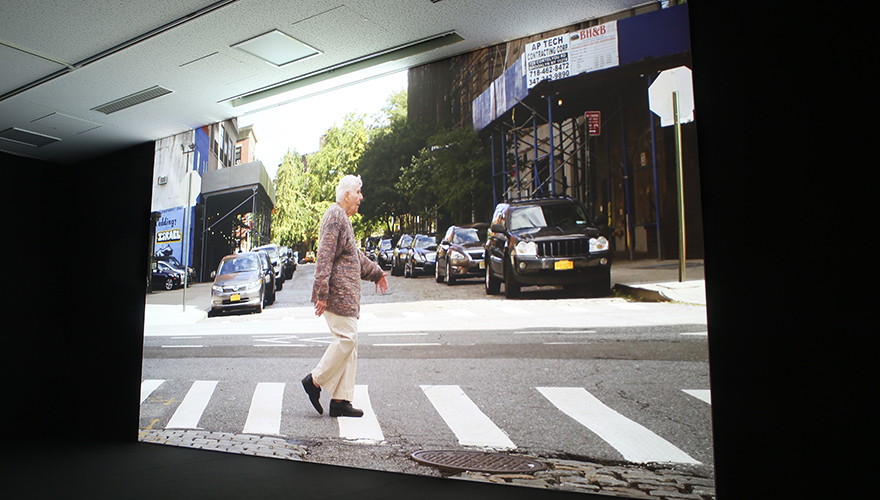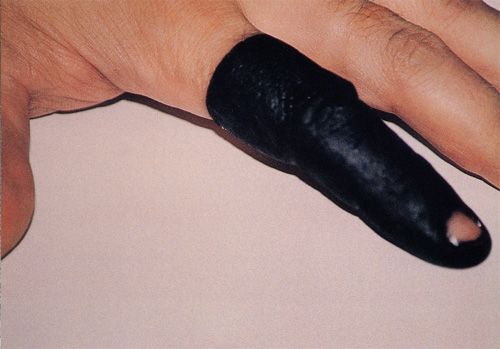.
Last June, I crippled myself—stupidly. Descending a staircase while reading, I missed a step, fell badly, and ruptured my quadricep. It had to be sewn back together. I came out of a brace several months later, wobbly—the muscle had withered. I’m still recuperating. I find it hard to climb stairs and to get in and out of cars, and will for a while. I thought my injury would make me feel special (in a bad way), but it had the reverse effect (I feel common). Having barely noticed them before, I became attuned to all those around me with leg issues—we are legion! Now, at every street corner, I see crutches, braces, moon boots, and prosthetic legs. I bear witness to varieties of limps and staggers, hops and hobbles. I’ve become quite the connoisseur. I’m reminded of Martin Creed’s video You Return Work No. 1701 (2013), which shows people with distinct walking disabilities, all happy to be filmed, crossing a Manhattan street one by one, as we hear the artist sing his song, ‘You Return’. The last, a man, presumably out of his wheelchair, pulls himself across the road, backwards, with two gloved hands. I first saw the video before my accident. Now I appreciate it in a new way. Take a look.
.
[IMAGE: Martin Creed Work No. 1701 2013]
•


Frozen Frame
.
Located in a former Nabisco box-printing factory, an hour from New York City up the Hudson River, Dia Beacon showcases a breathtaking collection of works by American minimalists and their family and friends. Dia Beacon may be one of the planet’s biggest contemporary-art destination experiences, but, chances are, if you’re only in New York for a few days, you’ll skip it. But I’m here for a while and take the opportunity. It’s my third visit since the place opened in May 2003.
Dia Beacon feels insulated—air gapped—from Manhattan’s density, intensity, urgency. The experience starts with the train trip to tiny Beacon (population less than 15,000). On the way, you decompress, chill, and leave the big smoke behind. The building’s massive footprint enables appropriately epic installations by Walter De Maria, Dan Flavin, Michael Heizer, and Richard Serra, along with expansive selections of classic works by John Chamberlain, Mary Corse, Don Judd, On Kawara, Sol LeWitt, Agnes Martin, Robert Morris, Blinky Palermo, Robert Ryman, Fred Sandback, Robert Smithson, Anne Truitt, and others. To give a sense of the scale, a single newly installed work—De Maria’s floor installation 360˚ I Ching/64 Sculptures (1981)—occupies 10,000 square feet.
The artists may all be mavericks, but common ideas and moves ripple through the works on show, stringing them together like beads. The artists favour industrial materials and processes; the hand is minimised. Works involve permutations of basic elements (De Maria, Flavin, Heizer, Palermo). There are mounds of dirt (Morris, Smithson). There are mirrors (Gerhard Richter, Smithson)—and CCTV operating as a mirror (Nauman). There’s shredded rubber (Serra) and sliced felt (Morris). There are plays on negative space (Heizer, Sandback). There are circular and square voids (Heizer) and circular, square, and triangular protrusions (De Maria). There are crushed cars (Chamberlain) and shiny restored ones (De Maria). Etcetera. Everything seems linked in this hall of mirrors, this echo chamber. Everything is in register.
Psychology and sexuality are banished, except in the downstairs Nauman room and the upstairs Louise Bourgeois one, with Nauman reading as the gimp in minimalism’s basement and Bourgeois as the madwoman in its attic. Even here, these exceptions operate within the orbits of acceptable minimalist-related strategies. Barthes would have called it ‘inoculation’. When odd artists like Andy Warhol and Richter are admitted, it is with specific works that tie them to the company—Warhol’s Shadows (1978–9), Richter’s Six Grey Mirrors (2003)—parking the rest of their concerns and achievements.
Everything connects in a minimalist end game. Almost every work seems to be a major statement, as if it appeared fully formed (immaculately conceived) and could be no other way. Dia Beacon leaves little sense of how the artists got here or of other ways art might go. While appearing to be a temple to artists as individuals, it’s aggressively and consumately curated, with everything fitting together, almost seamlessly. First impressions (wide open spaces) conceal the reality (no way out, no way in).
Dia Beacon always feels the same. Exhibits change at a glacial pace, if at all. Any changes are reiterations or absorptions. Dia Beacon argues its centrality and its marginality simultaneously. On the one hand, it asserts the eternal supremacy of American minimalism; on the other, it nags from the sidelines as a decadent, pluralistic art world goes its merry way, exploring issues and identity, representing stuff and doing business. Dia Beacon excites me and frustrates me in equal measure. Its back-to-basics formalism feels so serious and consequential, but also narrow and humourless, privileged and prescriptive. It’s an art day spa: visit for a cleanse; don’t eat there every day.
.
[IMAGE: Half of Walter De Maria’s floor installation 360˚ I Ching/64 Sculptures 1981, Dia Beacon]
•

Laughing at My Own Jokes
.
The other day, I found the blurb I wrote for a toxic little show I curated back in 2003, at Auckland Art Gallery’s New Gallery. It was called Pressing Flesh: Skin, Touch, Intimacy. Instead of labouring my point, I just described some of the works. ‘This rambling group show looks at themes of skin, touch, and intimacy—particularly bad intimacy. It takes in hysterical welts, playing tag in the nude, a slap-happy couple, live massage performance, a blackened digit, a passive-aggressive invitation, published romantic blacklists and wishlists, a plasticine painting, a skin collage, dank nude studies, deeply textured stockings, hairy soap, a stalker video, a pitted tongue, and, finally, a classic feminist vagina painting made by a guy.’ What was I thinking? And how generous of Director Chris Saines to let me think it. Those were the days. The show included Maria Abramovic and Ulay, Pat Brassington, Gordon Burt, Steve Carr, Derrick Cherrie, Julian Dashper, Luise Fong, Lucio Fontana, Douglas Gordon, Terrence Handscomb, Young-Hae Chang Heavy Industries, Jae Hoon Lee, Andrea Low, Mike Parr, Fiona Pardington, Peter Peryer, Ann Shelton, Santiago Sierra, Jed Town, Terry Urbahn, Rohan Wealleans, and Artur Zmijewski. By all means, try to match the names to the crimes.
[IMAGE: Douglas Gordon Three Inches Black 1997]
•
Who Am I?
I am a contemporary-art curator and writer, and Director of the Institute of Modern Art, Brisbane. I have held curatorial posts at Wellington’s National Art Gallery, New Plymouth’s Govett-Brewster Art Gallery, Dunedin Public Art Gallery, Auckland Art Gallery, and, most recently, City Gallery Wellington, and directed Auckland’s Artspace. My shows include Headlands: Thinking through New Zealand Art for Sydney’s Museum of Contemporary Art (1992); Action Replay: Post-Object Art for Artspace, Govett-Brewster Art Gallery, and Auckland Art Gallery (1998); and Mixed-Up Childhood for Auckland Art Gallery (2005). My City Gallery shows include Yvonne Todd: Creamy Psychology (2014), Julian Dashper & Friends (2015), Francis Upritchard: Jealous Saboteurs (2016), Colin McCahon: On Going Out with the Tide (2017), John Stezaker: Lost World (2017), This Is New Zealand (2018), Iconography of Revolt (2018), Semiconductor: The Technological Sublime (2019), Oracles (2020), Zac Langdon-Pole: Containing Multitudes (2020), and Judy Millar: Action Movie (2021). I curated New Zealand representation for Brisbane’s Asia-Pacific Triennial in 1999, the Sao Paulo Biennale in 2002, and the Venice Biennale in 2003 and 2015. I am co-publisher of the imprint Bouncy Castle.
Contact
BouncyCastleLeonard@gmail.com
+61 452252414
This Website
I made this website to offer easy access to my writings. Texts have been edited and tweaked. Where I’ve found mistakes, I’ve corrected them.
.